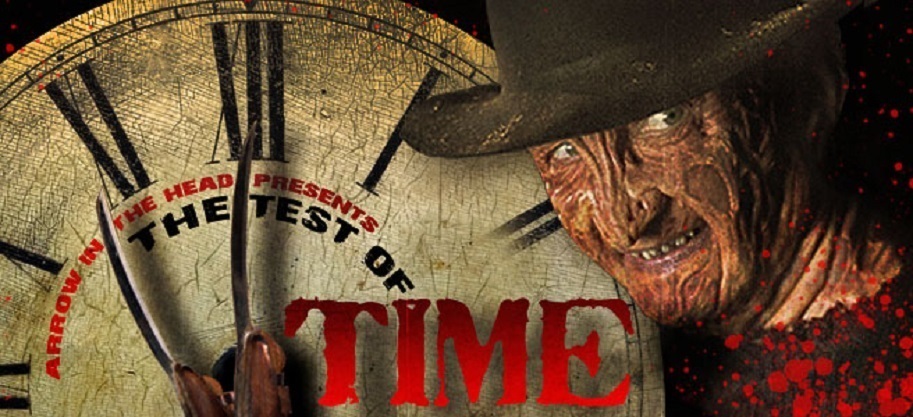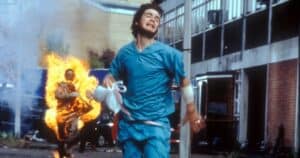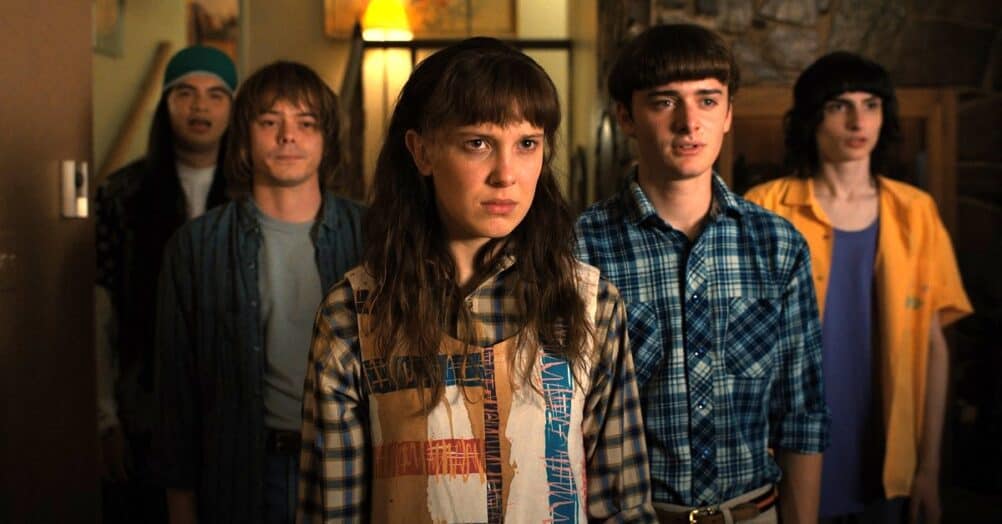Last Updated on August 5, 2021

We all have certain movies we love. Movies we respect without question because of either tradition, childhood love, or because they’ve always been classics. However, as time keeps ticking, do those classics still hold up? Do they remain must see? So…the point of this column is to determine how a film holds up for a modern horror audience, to see if it stands the Test of Time.

DIRECTED BY NICOLAS ROEG
STARRING DONALD SUTHERLAND, JULIE CHRISTIE, HILARY MASON, CLELIA MATANIA, DAVID TREE
Pass the Warning! Masterful HEREDITARY helmer Ari Aster has made no bones about the wide array of classic horror films from the 1960s-70s that influenced his daringly duplicitous debut. One such flick is Nicolas Roeg’s DON’T LOOK NOW, a dizzying display of grievous psychological dread. This movie, aside from boasting one of the all time gut-punching, nerve-clattering twist endings, has always been one of our personal favorites precisely because of the way it attempts an honest examination of grief before anything eerily supernatural occurs. Then of course there’s Donald Sutherland giving a grippingly internalized performance, whose character’s increasingly fractious mindset we’re tasked with navigating through in order to find the truth. It’s a hell of ride!
But you know the deal. One man’s pleasure is another man’s trash. And while I doubt many horror aficionados dismissed DON’T LOOK NOW when it hit theaters for the first time in 1973, what about now? Does Nicolas Roeg’s deliberate directorial sleight of hand translate to today’s audience? Do the jump-cuts and measured pacing still enthrall today the way it did in the golden-age of 1970s American cinema? Does the mounting dread still play as palpably as did 45 years ago? Does the shock-and-awe conclusion still pack an unrecoverable, wind-knocking wallop? Let’s find out below when we officially pit DON’T LOOK NOW up against the Test of Time!

THE STORY: Adapted from the 1971 short story by Daphne Du Maurier, DON’T LOOK NOW follows the grief-stricken exploits of married couple John and Laura Baxter (Donald Sutherland and Julie Christie). In one of the most disturbing opening sequences ever recalled, the Baxters' young daughter Christine (Sharon Williams) helplessly drowns in the pond outside the family’s English country home. Before we press on, let us note the tingling shivers sent through the spine of anyone with a pulse as a result of this scene. The way Sutherland plays this unimaginable discovery is nothing short of emotionally devastating. Of course, what better ways to set the tone, lay the stakes, and instantly elicit our sense of unbounded sympathy in the characters? Never mind the indelible imagery of Christine’s striking red rain coat (which we’ll expound upon, don’t worry), the profound dramatic heft of the opener alone perfectly sets up what inevitably follows.
Looking to leave their grief behind, the Baxters head to Venice, Italy – where John takes an architectural gig restoring an old church. While in Venice, Laura meets a blind seer named Heather (Hilary Mason) and her friend Wendy (Clelia Matania) at a restaurant. After the creepy old psychic lady claims to see Christine sitting between John and Laura in the eatery, Laura trades glum grief for bubbly enthusiasm. She wants to heed the seer’s advice, but John wants nothing to do with it. She’s open, he’s skeptical. This creates a rift in their relationship, despite one of the all times tawdriest sex scenes ever filmed (apparently this was the very first scene shot in the movie, taking place only hours after Christie and Sutherland met for the first time. Many have charged the couple with performing un-simulated sex in the scene, a claim that has been refuted for decades). Even when Laura tells John the psychic has warned that he is in direct danger, John shrugs it off as mere lunacy.
All the while, a serial murderer is felling victims across Venice. When Laura heads back to England to attend their son Johnny’s accidental injury, John is left to his own devices to traverse the fog-drenched Venetian canals and thin alleyways. He must not only elude the serial killer, John must uncover the mysterious image of a little girl in a red rain coat running around Venice…a spitting image of his dead daughter Christine!

WHAT HOLDS-UP: Look, when you so thoroughly transcend the horror genre to the tune of being Voted #1 on Time Out’s all time list of British Films, #8 on BFI’s list of Top 100 British Movies of all time, #18 on the Times list of 100 Greatest Films, included on Steven Schneider’s 1001 Movies You Must See Before You Die and named on Roger Ebert’s litany of Great Movies – yeah, you’ve held up pretty damn well. But aside from the masterful (mis)direction the great Nicolas Roeg dazzles us with, there are three irreplaceable elements in DON’T LOOK NOW that have stood tallest: the imagery, the drama and performance, and the head-swirling, pulse-thudding finale.
The hauntingly surreal imagery of DON’T LOOK NOW is beyond reproach. The idyllic image of that red rain coat established in the opening scene is unspeakably lasting. Associated with childhood innocence at first, only to be subverted as an image of abject evil in the end, the rain coat is right at the heart of the psychological tumult fomented in the viewer. Of course, the viewer witnesses this through John’s character, making the connection an organic one. By the time the red rain coat resurfaces in the final reel, depicted as a dreamily shrouded visage that is difficult to pin down only reinforces this kind of psychological unrest. The ethereal image haunts, as if a ghost’s ghastly gown, luring John into the uncompromising unknown.

Also, the old world Venetian setting is too inherently gorgeous to grow tiresome. The ancient architecture insolates itself from such criticism. And yet, for the purposes of a psychological horror story, the setting could not be more perfect. The blending of picturesque Venice with underlying grotesque menace of the story could not be counterweighted more precisely. The street-lit alleyways, fog-steeped canals, narrow corridors and grand gondola tours all tend to reinforce the John’s unraveling mind-state. Never forced or over the top, but subtly and subconsciously.
But the main reason why the horror grips us the way it does in the end is because of the dramatic stakes established in the beginning. The drama takes primacy over the horror, which is the most surefire way to keep the action empathetically involving. Straight up, after the harrowing opening sequence, nothing all that terrifying happens in the film for well over an hour. Nope, Roeg is more interested in exploring grief, guilt, regret, allowing these emotions to fester until they must be reconciled with as the horror unfolds. And yet, the two tones (drama and horror) are never extricable. Note these foreshadowing lines of dialogue spoken by John in the early going. When wondering why a frozen pond is flat despite a round Earth, John says “nothing is what it seems.” Later when Laura thinks John doesn’t believe the visions she’s having, he says “seeing is believing…I believe you.” Later yet he says that “the unconscious body reacts faster than the mind ever can.” These seemingly innocuous lines are anything but, they’re thematically woven into the narrative on purpose from the beginning.

This, in part, allows the film to transcend the horror genre en route to becoming something far richer. The performance of Donald Sutherland also adds to the transcendence. The way he skirts the supernatural, only to become an unwitting pawn on its behalf in the end, the way Sutherland achieves this without letting on is absolutely tremendous. Julie Christie is also great in the film, but it’s through Sutherland’s eyes that we witness the horror, even when we’re told DON’T LOOK NOW. It’s why the ending is difficult to lay eyes on!
And let’s talk about that ending, shall we? No, we’re not talking about the great rug-yanking twist in which Roeg reveals that John’s vision of Laura on a gondola-hearse to be a prophetic one regarding his own demise (itself commendable), we mean the final 15-minute chase scene through nighttime Venice. This is a masterfully exacted sequence of tension and suspense. John finally gives in to the idea his daughter may still be alive, as witnessed through the murky red rain coat appearing ever so slightly here and there. He spots the coat, chases it through a surreally labyrinthine series of canals and narrow passageways, ultimately cornering the entity in dark basement of some kind. With it’s back turned, the image of the rain coat so readily associated with Christine’s childhood innocence, is, in one fell swoop, mortifyingly subverted when the red-hood suddenly spins its head around. The reveal of a creepy old dwarf is heart-jolting enough, but when it pulls a blade and slashes John’s throat and watches the man futilely bleed out…it’s a knockout one-two combo to the head and gut.

WHAT BLOWS NOW: Too much bare Sutherland ass. Good god. I realize it was the 70s and all, and that Sutherland seems more comfortable being naked on screen than damn near anyone as mildly attractive as he is, but damn. Julie Christie’s derriere takes an unwarranted backseat (pun?) to Sutherland’s. Perhaps, then, DON’T LOOK NOW serves as more of a warning than a title.
Less flippantly, I actually think that Roeg undersells the serial killer aspect of the film too much for a little too long. Honestly, only two people are murdered in the film (until the finale) and neither is depicted onscreen. We hear the first one, and see the aftermath of the second one. By deemphasizing this serial killer element, we as audience members fail to make a connection between the little girl John keeps seeing and the identity of the serial killer. I suppose this is exactly the point, done on purpose to keep us misdirected, but in watching the film again, I think Roeg could have bolstered the serial killer subplot even more while still retaining the powerful impact of the movies ultimate reveal. I would never say anything about this flick blows now, but that did strike me as a bit uneven.
THE VERDICT: Almost a half century after its release, DON’T LOOK NOW still plays superbly as a simultaneous sinister psychological horror story, and a deeply disturbing domestic drama. Nicolas Roeg’s sure-handed directorial duplicity keeps us on edge, off -and constantly guessing as to what’s coming around each corner. That the horror plotline naturally derives from the protagonists’ characterizations of grief, guilt, regret, etc., organically allows for the much needed empathy to pay off in the grand finale. Couple this emotionally arresting execution of the story with the indelible imagery of old world Venice and that damn upsetting red rain coat…both facets of which come colliding in a heart-pounding final 15 minutes…and it becomes clear why DON’T LOOK NOW will ever be seen as anything other than the undisputed classic that it is. 45 years ago, presently, and forever more!





















Follow the JOBLO MOVIE NETWORK
Follow us on YOUTUBE
Follow ARROW IN THE HEAD
Follow AITH on YOUTUBE